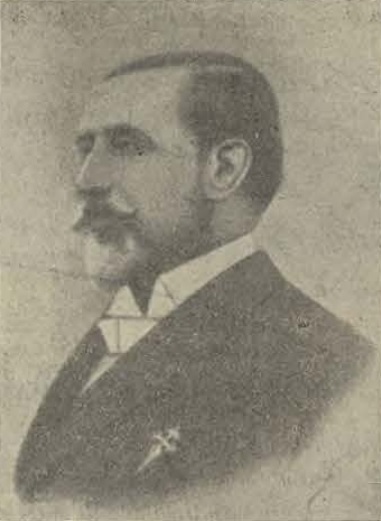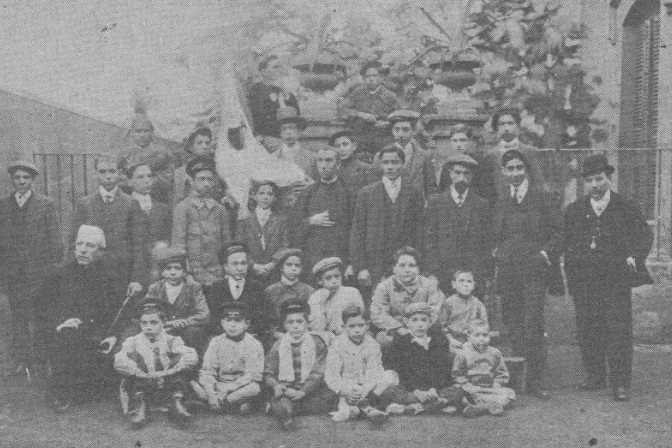|
José Luis Oriol Urigüen
José Luis de Oriol y Urigüen, 2nd Marquis of Casa Oriol (1877–1972), was a Spanish businessman, architect and politician. As an architect he designed few historicist residential buildings, some of them very prestigious today. As a businessman he was the moving spirit behind Hidroeléctrica Española and Talgo. As a politician he served as Conservative and Traditionalism (Spain), Traditionalist MP, growing into a local Álava tycoon. Family and youth José Luis Valentin Oriol was born to a distinguished Catalans, Catalan landowner family, his first ancestors recorded in the 17th century. The brother of his paternal grandfather, Buenaventura de Oriol y Salvador, was a prominent Carlist; in return for his service to the cause, Carlos, Duke of Madrid, Carlos VII made him marquis of Oriol in 1870. José's father, José María de Oriol y Gordo (1842-1899), pursued a military engineer career and as a colonel sided with the Carlism, legitimists during the Third Carlist War. Briefly on ... [...More Info...] [...Related Items...] OR: [Wikipedia] [Google] [Baidu] |
Bilbao
Bilbao is a city in northern Spain, the largest city in the Provinces of Spain, province of Biscay and in the Basque Country (greater region), Basque Country as a whole. It is also the largest city proper in northern Spain. Bilbao is the List of cities in Spain by population, tenth largest city in Spain, with a population of more than 347,000 as of 2023. The Bilbao metropolitan area has 1,037,847 inhabitants,Proyecto Audes making it the most populous metropolitan area in northern Spain. The Comarcas of the Basque Country, comarca of Greater Bilbao is the fifth-largest urban area in Spain. Bilbao is also the main urban area in what is defined as the Basque Country (greater region), Greater Basque region. Bilbao is located in the north-central part of Spain, some south of the Bay of Biscay, where the economic s ... [...More Info...] [...Related Items...] OR: [Wikipedia] [Google] [Baidu] |
Biscay
Biscay ( ; ; ), is a province of the Basque Country (autonomous community), Basque Autonomous Community, heir of the ancient Lordship of Biscay, lying on the south shore of the Bay of Biscay, eponymous bay. The capital and largest city is Bilbao. Biscay is one of the most renowned and prosperous provinces of Spain, historically a major trading hub in the Atlantic Ocean since medieval times and, later on, one of the largest industrial and financial centers of the Iberian Peninsula. Since the extensive deindustrialization that took place throughout the 1970s, the economy has come to rely more on the Tertiary sector of the economy, services sector. Etymology It is accepted in linguistics (Koldo Mitxelena, etc.) that ''Bizkaia'' is a cognate of ''bizkar'' (cf. Biscarrosse in Aquitaine), with both place-name variants well attested in the whole Basque Country (greater region), Basque Country and out meaning 'low ridge' or 'prominence' (''Iheldo bizchaya'' attested in 1141 for the Mo ... [...More Info...] [...Related Items...] OR: [Wikipedia] [Google] [Baidu] |
Neguri
Neguri is an affluent district of Getxo, in Biscay, Basque Country (autonomous community), Basque Country in Spain. It is traditionally regarded as the residence of the prosperous Basque people, Basque industrial bourgeoisie. Its name, coined in the 19th century, means ''Winter Town'' in Basque language. The neighbourhood is serviced by two Bilbao Metro line 1 stations, Neguri and Aiboa. References Populated places in Biscay Neighbourhoods in Spain Getxo {{Spain-geo-stub ... [...More Info...] [...Related Items...] OR: [Wikipedia] [Google] [Baidu] |
Santurtzi
Santurtzi (; ) is a port of Bilbao, port town in the province of Biscay, in the autonomous community of Basque Country (autonomous community), Basque Country, Spain. It is located in the Bilbao Abra bay, near the mouth of the Nervión river, on its Left Bank (Biscay), left bank, downriver from Bilbao and forms part of the ''Greater Bilbao'' urban agglomeration, agglomeration. It has a population of 45,853 (2019) and a land area of . The district of Santurce, San Juan, Puerto Rico, Santurce of the city of San Juan, Puerto Rico, San Juan, Puerto Rico derives its name from Santurtzi. History and Toponyms According to legends, the current church of St. George was originally founded as a monastery by English monks fleeing from religious persecution. They established themselves on the Basque coast, specifically the Somorrostro Valley, from which would later develop the town of Santurtzi. The name Santurtzi is derived from the Latin ''Sant Georgi'', as was the hermitage in Gordejuela ... [...More Info...] [...Related Items...] OR: [Wikipedia] [Google] [Baidu] |
Architect
An architect is a person who plans, designs, and oversees the construction of buildings. To practice architecture means to provide services in connection with the design of buildings and the space within the site surrounding the buildings that have human occupancy or use as their principal purpose. Etymologically, the term architect derives from the Latin , which derives from the Greek (''-'', chief + , builder), i.e., chief builder. The professional requirements for architects vary from location to location. An architect's decisions affect public safety, and thus the architect must undergo specialised training consisting of advanced education and a ''practicum'' (or internship) for practical experience to earn a Occupational licensing, license to practice architecture. Practical, technical, and academic requirements for becoming an architect vary by jurisdiction though the formal study of architecture in academic institutions has played a pivotal role in the development of the p ... [...More Info...] [...Related Items...] OR: [Wikipedia] [Google] [Baidu] |
Palacio De Oriol
Palacio (''palace'') is a Spanish habitational name. It may have originated from many places in Spain, especially in Galicia and Asturias. Notable people with the surname include: *Agustina Palacio de Libarona (1825–1880), Argentine writer, storyteller, heroine *Alberto Palacio, engineer *Alfredo Palacio (1939–2025), Ecuadorian cardiologist and politician, president of Ecuador (2005–2007) *Andy Palacio, Belizean musician *Emilio Palacio, Ecuadorian journalist *Ernesto Palacio, opera singer *Héctor Palacio, Colombian road racing cyclist *Milt Palacio, basketball player * R. J. Palacio, American writer of the 2012 children's novel ''Wonder'' *Rodrigo Palacio Rodrigo Sebastián Palacio Alcalde (; born 5 February 1982) is an Argentine professional basketball player and former association football, footballer who played as a second striker. He is the son of José Ramón Palacio, a historic player of C ..., footballer See also * Palacios (other) References {{s ... [...More Info...] [...Related Items...] OR: [Wikipedia] [Google] [Baidu] |
Francoist
Francoist Spain (), also known as the Francoist dictatorship (), or Nationalist Spain () was the period of Spanish history between 1936 and 1975, when Francisco Franco ruled Spain after the Spanish Civil War with the title . After his death in 1975, Spain transitioned into a democracy. During Franco's rule, Spain was officially known as the Spanish State (). The informal term "Fascist Spain" is also used, especially before and during World War II. During its existence, the nature of the regime evolved and changed. Months after the start of the Civil War in July 1936, Franco emerged as the dominant rebel military leader and he was proclaimed head of state on 1 October 1936, ruling a dictatorship over the territory which was controlled by the Nationalist faction. The 1937 Unification Decree, which merged all of the parties which supported the rebel side, led to Nationalist Spain becoming a single-party regime under the FET y de las JONS. The end of the Civil War in 1939 brou ... [...More Info...] [...Related Items...] OR: [Wikipedia] [Google] [Baidu] |
Requeté
The Requeté (; , ) was a Carlist organization, at times with paramilitary units, that operated between the mid-1900s and the early 1970s, though exact dates are not clear. The Requeté formula differed over the decades, and according to its changes, the history of the movement falls into several phases: 1) heterogeneous youth organisation (mid-1900s to mid-1910s); 2) urban street-fighting squads (mid-1910s to early 1920s); 3) dormant structure with no particular direction (early 1920s to early 1930s); 4) paramilitary party militia (1931–1936); 5) aarmy shock units (1936–1939); 6) party branch in-between youth and ex-combatant organisation (1940s–1950s); 7) internal "order of the faithful" (1960s). The Requeté played a major role in Spanish history in early months of the Civil War, when its units were critical for ensuring Nationalist advantage on some key frontline sections. It is not clear whether there is any Requeté network operational today. Background Apart fro ... [...More Info...] [...Related Items...] OR: [Wikipedia] [Google] [Baidu] |
Antonio María Oriol Urquijo
Antonio María de Oriol y Urquijo (1913–1996) was a Spanish people, Spanish politician and businessman. Politically he supported the Traditionalism (Spain), Traditionalist cause, first as a Carlism, Carlist militant and then as a Francoism, Francoist official. In 1955–1977 he was a member of Cortes Españolas; in 1957–1965 he headed the welfare department in the Ministry of the Interior (Spain), Ministry of Interior; in 1965–1973 he served as the Ministry of Justice (Spain), Minister of Justice; in 1973–1978 he was a member of the Council of the Realm and in 1973–1979 he presided over the Spanish Council of State, Council of State. As businessman he was active in companies controlled by the Oriol family, holding executive positions in Iberdrola, Patentes Talgo and other entities. Family and youth Antonio Oriol was born to a family of Catalans, Catalan origins, its first members noted in the history of Spain in the 17th century. Buenaventura Oriol Salvador sided with t ... [...More Info...] [...Related Items...] OR: [Wikipedia] [Google] [Baidu] |
José María Oriol
José is a predominantly Spanish and Portuguese form of the given name Joseph. While spelled alike, this name is pronounced very differently in each of the two languages: Spanish ; Portuguese (or ). In French, the name ''José'', pronounced , is an old vernacular form of Joseph, which is also in current usage as a given name. José is also commonly used as part of masculine name composites, such as José Manuel, José Maria or Antonio José, and also in female name composites like Maria José or Marie-José. The feminine written form is ''Josée'' as in French. In Netherlandic Dutch, however, ''José'' is a feminine given name and is pronounced ; it may occur as part of name composites like Marie-José or as a feminine first name in its own right; it can also be short for the name ''Josina'' and even a Dutch hypocorism of the name ''Johanna''. In England, Jose is originally a Romano-Celtic surname, and people with this family name can usually be found in, or traced to, the ... [...More Info...] [...Related Items...] OR: [Wikipedia] [Google] [Baidu] |
Onésimo Díaz Hernández
Onésimo Díaz Hernández (born 16 August 1966) is a Spanish historian known for his publications regarding the history of Spain in the twentieth century. Career Díaz studied History at the Complutense University in Madrid, the University of Navarra (Pamplona), and the University of the Basque Country (Vitoria-Gasteiz) and holds a Ph.D. in History from the University of Basque Country (1995) as well as a Ph.D. in Church History from the Pontifical University of the Holy Cross in Rome (2013). He is the author of thirteen books and has written multiple book reviews for journals including Arbor, the International Journal of Iberian Studies, and Hispania Sacra. He has published a book in the collection of monographs of the St. Josemaria Escriva Historical institute. It is entitled: "''Posguera. La primera expansion del Opus Dei durante los anos 1939 y 1940''". Díaz has been a contributor to newspapers such as ABC, El Mundo, Expansión, El Correo, Diario de Navarra as well a ... [...More Info...] [...Related Items...] OR: [Wikipedia] [Google] [Baidu] |




